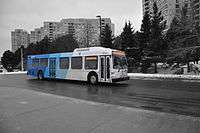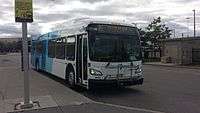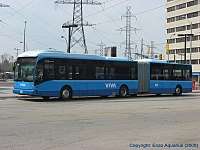York Region Transit
 | |
|
| |
| Slogan | York, connected. |
|---|---|
| Founded | 2001 |
| Headquarters |
50 High Tech Road, Richmond Hill, Ontario |
| Locale | York Region (with some service into Toronto and Brampton, Ontario) |
| Service area | Urban/semirural areas |
| Service type | Bus service, bus rapid transit |
| Alliance |
Toronto Transit Commission Brampton Transit |
| Routes |
97 YRT, 6 Viva, 5 TTC-contracted |
| Fleet |
406 YRT buses[1] 123 Viva bus rapid transit 97 Mobility Plus vehicles |
| Annual ridership | 22,822,806 (2016)[2] |
| Fuel type | Diesel |
| Operator | see Operations |
| General Manager | Ann-Marie Carroll |
| Website | yrt.ca |
York Region Transit (YRT) is the public transit operator in York Region, Ontario, Canada. Its headquarters are in Richmond Hill, at 50 High Tech Road.
YRT operates 65 full-time, rush hour and limited routes, 35 school services, and 6 Viva Rapid Transit routes. 5 Toronto Transit Commission (TTC) routes run within York Region's boundaries. TTC passengers who cross Steeles Avenue (the Toronto–York boundary) must pay an additional fare (the YRT fare) to continue on that route (in practical sense, the TTC bus becomes a YRT bus when it crosses Steeles Avenue).
Some YRT routes operate within the City of Toronto; these buses generally run to and from Toronto subway stations. YRT northbound buses are allowed to pick up passengers south of Steeles Avenue if they are heading into York Region (but passengers must flag the bus from a designated TTC or YRT stop). YRT buses heading to a TTC subway station can similarly drop off passengers at designated stops south of Steeles Avenue, but are usually not permitted to pick up passengers from these stops. As the majority of passengers are assumed to be transferring to and from TTC services, no extra fare is charged for riders boarding or disembarking YRT buses within Toronto.
Ridership
In 2016, average weekday ridership was approximately 71,500 on buses and 1,200 on MobilityPlus, a service for people with disabilities.[2] 22.8 million riders used YRT in 2016, a 1.4% increase over 2015.[1]
History
YRT was created by the regional government in 2001 to combine the four municipally-managed transit authorities in the region: Vaughan Transit, Markham Transit, Richmond Hill Transit, and Newmarket Transit (Aurora Transit had merged with Newmarket in 1999).
In mid-2006, the YRT logo was modified to bear closer resemblance to the Viva logo and, by the end of the year most of the YRT fleet and bus stop signs had their looks changed to bear the new colours.
Before 1973, several private transit operators provided services around York Region:[3]
- Toronto and York Radial Railway: radial railway along Yonge Street in Vaughan and Markham
- Maple Leaf - Markham Coach Lines: routes taken over by Gray Coach in 1929
- Travelways: operated briefly in Markham in 1973
- Newmarket Bus Lines: 1948–1958
- Newmarket Town Bus: 1958–1960s
- Aurora Bus Lines: operated until 1972
Operations
Transit services in York Region are divided into 4 divisions and are provided by private operators under contract.[4]
Viva BRT Division
The BRT division operates the 6 Viva Rapid Transit bus routes and uses the 196-bus garage near Leslie Street and 16th Avenue in Richmond Hill.[5] In 2015, Tok Transit began a 7-year contract, replacing Veolia Transportation (Transdev) as operator.[4]
North Division
The North division includes several bus routes in Newmarket, Aurora, King Township, East Gwillimbury and Georgina. Tok Transit also operates this division and is under contract until April 2020.[4]
Southeast Division
The southeast division includes routes in Markham, Richmond Hill, and Stouffville.[6] It is operated by Miller Transit who are under contract until October 2023.[4]
Southwest Division
Transdev Canada Inc. is under contract of this division until August 2020.[4]
Bus rapid transit
In response to escalating congestion on the region's roads, York Region's transit plan included a provision for a bus rapid transit (BRT) system along the Yonge Street and Highway 7 arterial corridors. This service, known as Viva, was launched in September 2005.
Fares

Fares for riding both YRT can be paid by cash, tickets, or passes (including Presto cards); the latter two offering savings over cash. As of 1 July 2018, YRT fares are as follows (the same applies for the YRT's express bus service, Viva):[7]
| Fare Category | PRESTO or YRT Pay app |
Cash Fare | Monthly Pass |
|---|---|---|---|
| Adults | $3.75 | $4.00 | $150.00 |
| Youth | $3.00 | $4.00 | $117.00 |
| Child / Senior 65+ | $2.35 | $4.00 | $63.00 |
| Express (All age groups) | $4.25 | $4.50 | $171.00 |
| Weekly Pass | |||
| Greater Toronto Area | $63.00 | ||
| Fare Supplements | |||
| Ride to GO | $1.00 | ||
| Express Upgrade | $0.50 | ||
Three separate methods of payments are used by transit routes serving York Region:
- a "pay as you board" on conventional YRT routes, Züm Queen, and TTC-operated routes heading towards Toronto
- a "pay as you leave" on TTC routes heading away from Toronto
- a "proof of payment" basis on all Viva routes.
York Region's rapid transit bus service, Viva operates on a "pre-paid proof-of-payment (POP)" system, meaning passengers in possession with POP can board these buses at any door. Unlike conventional YRT buses, Viva buses are not equipped with onboard fareboxes, which means passengers are required to purchase paper tickets and passes at fare vending machines, tap a Presto card on the fare readers or activate their mobile ticket/pass at the platforms prior to boarding. If using an unvalidated ticket, it must validated it at a ticket validator machine, known as the "vivaNow" machine prior to boarding. When a ticket is validated, the date and expiry time are printed on the ticket. If using a single ride ticket, the date and expiry time are printed on it at the time of purchase so it does not need to be validated. (Paper POP tickets/transfers are not issued to YRT pass holders, Presto card holders as well as the YRT pay app (mobile ticket/pass) users since they act as POP). Time-based fares/transfers allow for unlimited travel within York region on a single fare for two hours.[8]
Fare zones
On July 1, 2017, YRT removed fare zones allowing customers to travel within the region with only one fare. [9] Previously, the YRT/Viva service area was divided into three fare zones. Zone 3 was defined as the portion of York Region north of Ravenshoe Road, while Zones 1 and 2 were divided by Bloomington Road for northbound passengers, and just south of King Road for southbound passengers. Passengers crossing a zone boundary would have to pay a zone fare supplement in addition to the regular fares.
GO Transit co-fares
As with many other transit agencies within the GTA, YRT offers a reduced fare for passengers transferring to YRT or Viva buses from GO Transit. Passengers may transfer at a GO train station from a GO Transit route to a YRT/Viva route and pay the reduced fare with the GO Transit proof of payment.
- Though Viva Purple and Viva Green do not directly serve Unionville GO Station, GO Transit co-fares are accepted when boarding either route at Enterprise Vivastation.
- Due to the proximity of Richmond Hill Centre Terminal and Langstaff GO Station, GO Transit co-fares are accepted when transferring between GO services at Langstaff GO station and YRT services at Richmond Hill Centre.
The GO Transit co-fare is expanded for passengers with the Presto card: passengers will automatically be assessed the co-fare (and any YRT fare supplements, if necessary) when transferring from GO Transit to YRT/Viva regardless of where the passenger boards the YRT bus. Similarly, passengers transferring from YRT/Viva to GO Transit will also be reimbursed the difference between the YRT fare and the co-fare upon disembarking from GO Transit (effectively, the YRT portion of the journey is paid with a co-fare).
TTC fares in York Region
Buses
YRT routes operated by the TTC on behalf of York Region allow passengers to board a TTC bus in York Region and disembark in Toronto and vice versa. Though considered a single route by both agencies, passengers crossing Steeles Avenue on a TTC bus must pay separate fares for the portion north of Steeles Avenue (where the bus is operated as a YRT route) and south of Steeles Avenue (where the bus operates as a TTC route). This means that passengers effectively transfer between a TTC route and a YRT route of the same name and number at Steeles Avenue.
- All passengers boarding in Toronto must pay the regular TTC fare upon boarding. Upon crossing into York Region, TTC buses operate on a payment-on-exit policy, where the YRT fare must be paid on disembarking, even if passengers board within York Region. This essentially prevents the use of the rear door for disembarking on northbound vehicles. However, passengers disembarking at Steeles Avenue do not have to pay YRT fares, even if disembarking on the north side of Steeles Avenue.
- Passengers boarding in York Region and disembarking in Toronto must pay both YRT and TTC fares upon boarding and receive a transfer as proof-of-payment. The transfer is not issued to passengers who pay only a YRT fare for travel within York Region only. Buses will stop on the north side of Steeles Avenue to ensure that all passengers have TTC proof of payment before proceeding into Toronto. However, passengers boarding at Steeles Avenue on either side do not have to pay YRT fares.
- Passengers may pay for YRT fares using a combination of TTC tickets/tokens and a cash supplement on these routes only; the cash supplement is the difference in fare value between the TTC fare media and its YRT counterpart.
- Currently, customers using TTC in York Region are advised NOT to use Presto, and to continue using alternate payment methods such as cash, paper tickets, passes, GTA weekly pass or the YRT Pay app, this is because the Presto card is not accepted for the YRT co-fare on YRT routes operated by the TTC, as the TTC has not yet integrated the YRT co-fare agreement on TTC buses operating within York Region, (although the TTC fare may be paid using Presto so long as the buses are operating within the City of Toronto).
- YRT does NOT issue paper transfers for passengers paying by Presto card (except for those transferring between GO Transit, YRT, and TTC operated routes in York Region); so therefore a separate fare is required for passengers wishing to transfer between YRT and TTC routes in York Region.
- Due to the "pay as you leave" policy in effect travelling northbound in York Region, passengers may not use Presto readers on the Viva ticket vending machines to pay for the YRT fare at Sheppard West Station or Don Mills Station (both stations connect to TTC routes serving York Region).
- Exception: Passengers transferring to a TTC route in York Region from a GO train station may use the Presto Card as GO Transit proof of payment and pay the co-fare in cash.
- As the portions of TTC routes north of Steeles Avenue are operated on behalf of YRT, the "TTC Times Two" program, allowing a single TTC fare to be paid for transfers between two TTC routes separated by an intermediate leg on GO Transit, is not offered for portions of TTC routes north of Steeles Avenue.
YRT also offers the "GTA Weekly Pass", which acts as a pass for the TTC, YRT, MiWay, and Brampton Transit; the pass is good for single-zone travel in York Region. Passengers wishing to cross zone boundaries must pay any zone fare supplements in cash.
Though certain YRT routes enter Toronto city limits, due to City of Toronto regulations, passengers may not board inbound (towards Toronto) YRT routes while in Toronto, nor disembark on outbound (away from Toronto) YRT routes while in Toronto. The only exception to this was transferring to inbound Viva Orange at York University, implemented to relieve overcrowding on its 196 York University Rocket route. Similarly, as a result of additional fare integration with the TTC, passengers could travel between York University and the fare-paid area of Sheppard West Station on Viva Orange with TTC proof-of payment; passengers wishing to travel beyond York University were required to have YRT fares. This was ceased with the opening of the Line 1 Yonge–University subway extension in December 2017.
Subway
On December 17, 2017, the western branch of the Line 1 subway was extended into York Region. Coinciding with that opening, YRT took over the operation of four TTC-operated routes in Vaughan. Unlike the policy with contracted TTC buses north of Steeles, no extra fare is charged when boarding or disembarking at Highway 407 and Vaughan Metropolitan Centre stations in Vaughan, due to the impracticality of a payment-on-exit system.[10] However, a YRT or TTC fare is required when transferring between YRT bus routes and the subway at these stations. This also applies at stations bordering or located entirely within Toronto, such as Pioneer Village, Finch, and Sheppard West.
Brampton Transit fares in York Region
Due to an agreement between YRT and Brampton Transit, passengers boarding Züm Queen east of Highway 50 (which largely duplicates service with Viva Orange while in York Region) will be assessed YRT fares, even if intending to disembark in Brampton. As a Brampton Transit route, passengers may also use Brampton Transit fare media (including those loaded onto a Presto card) to board this route without any additional fares being assessed. Passengers boarding with YRT passes will not be issued transfers for connecting to Brampton Transit routes in Brampton, nor will passengers boarding with Brampton Transit passes be issued transfers for connecting to YRT routes in York Region.
Passengers connecting from Züm Queen to YRT services and then to TTC services in York Region and paying by Presto card may request a special transfer upon boarding Züm Queen; this transfer acts as proof of payment only when boarding the TTC service.
Brampton Transit and YRT have cooperated on routes connecting Brampton and Toronto via York Region, and for a time, certain YRT routes were jointly operated by YRT and Brampton Transit buses, where both agencies' fare media were accepted. The introduction of Züm Queen has largely ended joint operation of YRT routes, and the acceptance of YRT fares on Brampton Transit routes while in York Region are the last vestiges of such cooperation.
Vehicles and fleet rosters



YRT has 123 Viva bus rapid transit vehicles, 406 YRT buses, and 97 Mobility Plus vehicles.[1] The initial fleet consisted of buses from previous York Region operators, but has since been expanded with YRT-bought vehicles.
For Viva bus fleet, see Viva Rapid Transit for details.
| Make/Model | Description | Division | Year | Fleet # | Notes |
|---|---|---|---|---|---|
| New Flyer Industries D40LF | 40' Diesel bus | Southwest (Transdev), Southeast (Miller), North (TOK Transit) | 2003–2010 | 311–335, 401–412, 571–585, 601–609, 610– 618, 701–730, 801–819, 901–945, 1001–1019 | |
| New Flyer Industries D40LFR | 40' Diesel bus | Southwest (Transdev), Southeast (Miller) | 2010–2011 | 1020–1038, 1101–1120[12] | |
| New Flyer Industries XD40 Xcelsior Bus | 40' Diesel bus | Southwest (Transdev), Southeast (Miller) | 2014 | 1401–1434[13] | |
| Nova Bus LF Series | 40' Diesel bus | Southwest (Transdev), Southeast (Miller), North (TOK Transit) | 2015–2017 | 1501–1518, 1601–1614, 1615–1621, 1701–1715 | |
| Van Hool New A330 | 40' Diesel bus | Southwest (Transdev) | 2005–2006 | 501–520 | |
| ElDorado National EZ Rider II | 30' Diesel bus | Southwest (Transdev), Southeast (Miller), North (TOK Transit) | 2005–2006 | 541–553, 555–562, 564–570, 619–621, 623 | |
| ElDorado National EZ Rider II MAX | 30' Diesel bus | Southwest (Transdev), Southeast (Miller), North (TOK Transit) | 2008–2009 | 850–868, 980–990, 991–996 | |
| ElDorado National EZ Rider II BRT | 30' Diesel bus | Southeast (Miller), North (TOK Transit) | 2010–2011 | 1060–1072 1160–1162 | |
| Arboc Spirit of Mobility 20D Accessible bus | 10 passenger wheelchair accessible bus | Southwest (Transdev), North (TOK Transit), Mobility Plus | 2012 | 1180–1187, 1188–1197 |
![]()
Fleet colours
 YRT old fleet colours 2001–2005
YRT old fleet colours 2001–2005- YRT current fleet colours 2005–present
YRT's first fleet (2001–2005) was painted with a white base with blue and gold stripes. During the early years many buses still had their pre-2000 colours from the previous operators with "YRT" painted on the front and sides. The livery was changed after 2005 to a white and several tones of blue. Only the Viva fleet is all-blue, but one Orion I YRT (#2028) was painted all-blue for a colour demo.[14] During the transition to the second colour theme some buses were all white with the old "YRT" label remaining.
Staff
YRT operating staff are employed by their respective contractors.
Uniforms
Bus operating staff uniform consists of a light blue shirt with YRT/Viva crest on the left chest and grey pants.
Transit enforcement
Fare Inspectors and Special Constables patrol the entire transit system for the safety and security of passengers and to ensure compliance with the proof-of-payment system. They make random checks onboard buses to ensure the proper use of tickets, transfers and passes. Customers without valid fares are subject to a warning, an instant fine or a criminal charge.
CCTV cameras
In 2006, YRT began installing 150 cameras on YRT (including Mobility Plus) and Viva buses. By the end of 2008, there were to be 210 more cameras added to the two systems.[15] CCTV cameras are also installed in some of the Vivastations in Richmond Hill.
Routes
YRT-owned facilities

YRT owns a few facilities: many are shared with other transit agencies like the TTC, GO Transit and Brampton Transit.
- Richmond Hill Centre Terminal - has bridge connecting to GO train station
- Vaughan Mills Terminal - platforms only; no terminal building (shelters only)
- Bernard Terminal - driveway and platforms only
- Promenade Terminal - platforms only; no terminal building (shelters only)
- Pioneer Village Terminal - at Pioneer Village subway station
- SmartCentresPlace Terminal - currently under construction; adjacent to Vaughan Metropolitan Centre subway station
- Vaughan Metropolitan Centre Vivastation - covered transfer facility at Vaughan Metropolitan Centre station
- Numerous Vivanext stations along on-street Rapidways
Garages used to store buses are owned by contractors.
2011–2012 labour strike
Starting on October 24, 2011, bus drivers and workers contracted by Miller Transit, First Student and York BRT Services (Veolia) started striking, protesting over wages and benefits for three months. Over 60 percent of YRT bus routes in York region and all Viva routes did not operate. YRT and Viva workers started picketing on December 5, 2011, at Finch-GO Terminal, YRT headquarters, South-West Division Garage, and Richmond Hill Centre Terminal. 96% of all YRT/Viva routes returned to service on February 4, 2012, and 98% of services were operational on Monday, February 6, 2012. Full YRT/Viva service resumed on February 27, 2012. To compensate riders for the three months of service disruptions, York Region Transit provided two months of free service, using the money saved by not having to pay striking workers.
Officers
In December 2014, the executive of YRT consisted of:
- Chair: Wayne Emmerson (as York Region Chair)
- Vice-Chair (Regional Councillor): Dave Barrow
Operational executives are:
- Commissioner of Transportation Services: Daniel Kostopoulos
- General Manager: Ann-Marie Carroll - became GM December 2014 and interim GM from early 2014 to December 2014[16]
- Richard J. Leary served as GM from 2010 to 2014; he had been Massachusetts Bay Transportation Authority chief operating officer and replaced YRT's first head Donald Gordon (2001–2009)[17] and left in early 2014 for the Toronto Transit Commission)
- Vice-President of York Region Rapid Transit Corporation: Mary-Frances Turner
See also
| Wikimedia Commons has media related to York Region Transit. |
References
- 1 2 3 "Fast Facts". www.yrt.ca. Retrieved April 7, 2018.
- 1 2 "2016 Transit System Performance Update" (PDF). York Region. Retrieved April 7, 2018.
- ↑ "Transit History of Ontario Communities (S-Z)". Retrieved February 3, 2016.
- 1 2 3 4 5 "Transit Operations and Maintenance Contracts" (PDF). York Region. May 1, 2014. Retrieved March 31, 2018.
- ↑ "transit facility / Richmond Hill". vivanext.com. York Region Rapid Transit Corporation. Retrieved 6 February 2018.
This 481,679 square-foot facility includes energy-efficient and environmentally-friendly features and will be used to maintain and store up to 196 YRT/Viva transit vehicles.
- ↑ "About Miller Transit - Miller Transit". Miller Transit. Retrieved 2018-03-31.
- ↑ "YRT/Viva Prices". York Region Transit. 2018-07-01. Retrieved 2017-08-03.
- ↑ "PRESTO launching in York Region July 18". Archived from the original on July 15, 2011. Retrieved July 16, 2011.
- ↑ "Fare changes coming July 1". York Region Transit/Viva. Retrieved 2017-05-24.
- ↑ James Bow. "A Subway to York University and Beyond: North of Finch". Transit Toronto.
- ↑ "York Region Transit 311-335 - CPTDB Wiki". Cptdb.ca. Retrieved 2013-10-05.
- ↑ "York Region Transit 1101-1120 - CPTDB Wiki". Cptdb.ca. Retrieved 2013-10-05.
- ↑ "York Region Transit 1401-1434 - CPTDB Wiki". Cptdb.ca. Retrieved 2013-10-05.
- ↑ Archived February 2, 2009, at the Wayback Machine.
- ↑ MyTransit Fall 2008
- ↑ "CUTA". CUTA. Archived from the original on March 5, 2016. Retrieved February 3, 2016.
- ↑ David Fleischer (January 26, 2010). "York looks south for new transit boss". yorkregion.com. Metroland Media Group. Retrieved February 4, 2010.
Works cited
- Markham Transit 1990 Rider's Guide, Town of Markham
- Markham Transit Fall 1994 Rider's Guide, Town of Markham
- Markham Transit Fall 1999 Rider's Guide, Town of Markham
- Markham Transit 2000 Rider's Guide, Town of Markham
- Transit History...Vaughan
- Transit History...Markham
- Transit History...Richmond Hill
- "vivatalk - York Region's Rapid Transit Update", Economist & Sun/Sun-Tribune: Community, June 11, 2005, p 7.
External links
- York Region Transit
- YRT fleet roster on CPTDB Wiki
- York Region Transit (Canadian Public Transit Discussion Board)
- The Toronto LRT Information Page (Page has a rendering of what a Viva LRV could look like)
- Drawings and photos of York Region Transit buses
